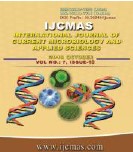


 National Academy of Agricultural Sciences (NAAS)
National Academy of Agricultural Sciences (NAAS)

|
PRINT ISSN : 2319-7692
Online ISSN : 2319-7706 Issues : 12 per year Publisher : Excellent Publishers Email : editorijcmas@gmail.com / submit@ijcmas.com Editor-in-chief: Dr.M.Prakash Index Copernicus ICV 2018: 95.39 NAAS RATING 2020: 5.38 |
Sapota (Achras zapota L.) is one of the tropical climacteric fruits preferred by the consumers due to its sweet taste and aroma. Fruits become ripe very quickly after harvesting due to sudden climacteric rise with high respiration rate and ethylene production. This quick ripening causes loosening the texture of fruit leads to softening of and spoilage. The short shelf life of the fruit is a marketing problem which is a major cause of huge postharvest loss of this fruit. Edible coating of fruits can reduce the ripening rate by making a thin layer above fruit surface to interfere gaseous exchange between air and fruit which ultimately reduce respiration rate and ripening. Chitosan is one such edible coating material frequently used in fruits to enhance storage life. In the present experiment solution of chitosan powder (0.5, 1.0, 1.5 and 2.0% w/v) has been prepared in 0.5% glacial acetic acid with surfactant and plasticizer. Freshly harvested and washed sapota fruits were then dipped in coating solution for 1 min followed by air drying. Fruits were then stored in controlled condition (12+1 oC, 85-90% RH). 1.5% chitosan coating resulted best for keeping the maximum fruits (more than 75%) for 30 days under controlled condition. Chitosan coating also reduced the physiological losses in weight compared to the uncoated fruits. The same treatment has also resulted maximum retention of quality by maximum TSS, total sugar and reducing sugar.
 |
 |
 |
 |
 |